Welcome to the “QUICK REVIEW”, in which I plan to run on the basis of photos from the garden as it is “today” with a little commentary. We’ll revisit some of the Crazy Plants and featured wild life to see how they are going as well as get a sneak peak into future blogs. We’ll get a seasonal glimpse at what is happening now in Perth conditions and hopefully find a few surprises…… both in the ground and my crazy obsessions elsewhere!
Having said that my “quick review” opened my eyes to so many fascinating parts of the garden….. from the skyline series to a million ways for growing sweet potato…. I WILL keep it brief this time, but think we’ll need to revisit/investigate so much of what I have discovered over the last few weeks!
(By the way, I’ll be at the International Permaculture Day Celebrations at the Stirling Farmers’ Markets – in the carpark of the Stirling Council Office on Cedric Street – on Sunday May 3rd. If you’re in the area, pop in and say hi. If you’re not, then look up your local celebration via the same link. It’s a great opportunity to learn about Permaculture off the locals!)
The Easter Long Weekend 2015 – what happens early April (followed by a little rain!)?
1. Fruiting Plants –
Apples and olives (just a few):
Grapefruit (we think – the tree was rescued when a neighbour made way for a triplex, so we’ll see which citrus is which over the next few months) plus some sneaky bananas (our first bunch, tropical micro-climate seems to suit it):
The baby luffa vine growing up our “reciprocating roof” structure with its new little fruit (exfoliation anyone? These are amazing, remind me to add them to my Crazy Plants list) and the last of the plants to make the fruit photo wall is the snake bean production (seeds for next planting season!)
2. Flowering Plants – who says Permaculture is not neat! Just look at those patterns…
Klip Dagga about to bloom and a few snaps of those determined sunflowers from out the front.
Pineapple sage, Frangipani beyond the “deciduising” Maple (I just like the arty photo so had to sneak it in!)
The Aloe Vera Flower and it’s fruit (see the little green ball up the stem!)
Lucerne / Alfalfa flowering and even the pond reeds are getting in on the action…
3. Seedlings –
The survivors…. in the photo on the left we have examples of the Maple, Ice-cream Bean, Persimmon, Luceana and a tiny Wild Tomato in photo 1. Photo two is the basil I tried to grow when I needed to know I could at least grow something (see failures below!). This was a pick me up effort…..
OKAY – You said you wanted to see my failures… well here is a big one:
I planted and loved dearly 8 seeds in little coco peat expanding pellets. I documented clearly on them the name from the packet which was all in Italian, so i thought it would be a nice surprise…. looked like a leek/shallot type plant…. Only two showed their heads and of those only one decided life was worth living. So I transplanted the remaining chap, when large enough (I thought) and put it out in the seedling patch…. where it promptly had every leaf eaten off. This is it now in the blue pot (about a month later) still standing, but barely surviving off the photo synthesis of its now denuded stems…. also the name I wrote down for the plant is nowhere on the internet and I cannot find the packet… hoping to get some leaves back so the Guru can tell me what I have grown!
Failure all round with this one, but you wanted the “worts and all”! The silver lining is, that whether it is an intended plant or actually a “weed” (in the commercial sense – we eat most of our weeds! See the dandelions in the pot above), it has staying power and is obviously tasty! Gotta hope it pulls through.
On a slightly more successful note, of the 4 tree lettuce that I planted in the wrong season, two made it into the ground and one has survived (in my make-shift “helmet”) the autumn under the maples! (The other is suspected of having fallen prey to the mole cricket echo chamber incident discussed below!) And my big win is the ginger in the right hand photo (pity I have hated the taste since I was little!). This second photo is one I plan on giving to an elderly chap up the road who has always wanted to grow it. Ginger growing tip for beginners – plant a knob of ginger submerged in coco peat without any soil (or love) within a box lined with plastic to act as a wicking pot. Then proceed to worry about it getting water logged and mouldy…. hence water it erratically and forget about it as often as you can, preferably during sweltering weather…. breed them tuff I say! Luck of the draw for me or perhaps the fact that someone else picked which knobs to plant might have been the critical stage. Anyway this is one to be gifted, below it is the rest of the box looking like a bonsai ginger forest – I look forward to digging them up and seeing what’s happening under the ground.
4. Froggy friends – enjoying both the ponds and the wicking bed pipes!
It must be getting cooler as our pipe friend (pretty chuffed our wicking bed under there must be healthy!) would normally spend his summer days up in the Pawpaw canopy. Never saw him make his way up there, but you could see his shadow up on the leaf well above head height.
And now for something a little weird…..Pond patterns – I spend a lot of time watching the surface of the pond (kind of like the way you watch a fire, only without the warmth….) The tadpoles provide a rhythmic movement. Call it pond telly – Duckweed (left) and Azolla (right) channels. Even without the moment, the patterns can be mesmerising, or it might just be me!
Other Pest Protection – our resident mum + dad (3 bubs last year!) act as our chook run fly control, but they also as our alarm system for cats, birds of prey and other interlopers.
5. Skyline Series –
I found a new angle on life while I was out photographing the yard. Feel free to skip this bit if you’re less interested in mental meandering, but I found I had been looking so hard at seedlings, pretty plants, fruiting plants and creatures, that I had forgotten the larger beasts that provided protection for them all over the hot summer. This will be hugely relevant when we go on to complete our Urban Permaculture Design. So here is my tribute to the big guys….
 LEFT: Pepper tree top (shelter’s most of yard in summer and severely trimmed through winter – we like to think of it as artificially deciduous, bee attractor, can cope with anything and supports the kids tree house!), paper bark (swarming with bees at the moment, pond shelter and generally beautiful bark giving great mood to pond area)
LEFT: Pepper tree top (shelter’s most of yard in summer and severely trimmed through winter – we like to think of it as artificially deciduous, bee attractor, can cope with anything and supports the kids tree house!), paper bark (swarming with bees at the moment, pond shelter and generally beautiful bark giving great mood to pond area)
BELOW: The pawpaw canopy (fruit, denser shade, increased humidity and froggy lookout – plus I just love the leave patterns at eye height and above.) with Maple beyond (brilliant early deciduous trees; spring bee attractors; passionfruit trellis, hammock supports, again increased humidity for the pawpaws, most importantly though it provides the neighbour’s east house walls with shade in the summer morning and midday and our garden with summer shade midday and into the afternoon)
From top to bottom – Maple, sweet potato (trellised up along wires for future shade… next summer), Necterine (one half of tree with Peach on the other), and then a fig in the foreground. Layer upon layer upon layer – Gardening like a Forest.
This next view is looking up at a two story duplex at the back of our place…The “tropical patch”. There are bananas off the the left, wisteria coming across, various citrus across the front (including the grapefruit featured earlier, bana grass loving the location at about 6-7m, then on the right is the Luceana (full grown) and in front of this is the Carambola (star fruit – in flower at the moment). Busy spot and that is just the canopy!
 This next one is the Skyline at the front from left to right – Pepper tree (summer shade, bees multiple times per year), bottle brush (birdlife, privacy and house shade in summer), Kale tree (8ft now – predator habitat all year round); bana grass (privacy, summer shade and test of whether it will do well there – yes, its about 4-5m tall, plus we get to cut it out and share it with others), then there is the old dead pepper (who we have met before – with the native climber which is sporadically swamped with lab labs and what ever other edible takes a fancy to climbing).
This next one is the Skyline at the front from left to right – Pepper tree (summer shade, bees multiple times per year), bottle brush (birdlife, privacy and house shade in summer), Kale tree (8ft now – predator habitat all year round); bana grass (privacy, summer shade and test of whether it will do well there – yes, its about 4-5m tall, plus we get to cut it out and share it with others), then there is the old dead pepper (who we have met before – with the native climber which is sporadically swamped with lab labs and what ever other edible takes a fancy to climbing).
These photos are simply of the pepper tree out the front of our place which is in flower and the bees are loving it. Whilst they can be tricky with their constant suckering, in our climate, anything that can stick it out all summer with no watering, partially protect our winter beds through summer and provide a refuge (and playground) for our critical fauna is okay by me. See the bees having a ball! Drawing bees into the garden all year round is critical for extending the bulk growing seasons and ensuring that those different little micro-climates (often catering to the more exotic species) are serviced when required.
And finally the blood sun from the other night as the sky was yet again ominously darkened by smoke. For me, this photo has the feel of the end of summer and the change of season….
6. That ole’ Cotton Bush – New angle on an old theory….
Cotton is now flowering in all its glory….
And then it rained – and all the others quickly opened…. everywhere I read the discussion that cotton is distributed by wind (blowing along open plains) or used by rodents etc to line their nests…. but what if they await the rain, the cotton buds get so heavy that they drop off and are carried away with running water…. it just seemed funny that I had waited and waited, and with a light rain in early autumn the first two opened over a week or so and then we had a significant downpour. The others all opened at once…. Whilst much less beautiful when soggy, the use of all that cotton surrounding the seed takes on a new purpose – a floaty. The below photos were taken after the first section of the downpour, our fluffy beauty looking pretty smoodged, but the others are opening.
7. Did I mention I have a problem….. I’ve gone a little Sweet Potato Crazy….. have I mentioned I love experimenting with sweet potato as they are so forgiving and endeavour to grow no matter what you do – the following needs little commentary, but needless to say I’m testing out their propensity to survive in any number of locations….
Firstly the normal way – left is the purple skin and white flesh variety, the right one is the orange skin and orange flesh variety…..
(Experiment Notes – the wind blew the purple one off the ledge and the top broke off at the kink….. the base did not grow more shoots, but the top when placed in water grew more roots and continued to grow the leafy vine. This potato has been living off its own reserves since early February and, with several cuttings removed and placed in water, is still growing strong… Orange potato less rampant, but perhaps will turn out to be a better climber. My understanding is that you can also cut a sweet potato into inch long bits along its length and each will start with roots and shoots…. will test that theory next time.)
The below is an orange-ish skin and a white fleshed on, that would not fit in a cup…. so I cut it in half and its growing strongly (about as good as the purple one) out of both ends in only an inch of water. Again with one has been in there since early Feb and still going strong.
The below left photo is a group of white flesh and white skinned sweet potatoes that I did not know about when the Guru went on his month sabbatical and the little lovelies looked after themselves…. they are just sitting on coco peat. The below right photo is the cuttings in water going strong as they wait for a deserving garden….. luckily the garden is nearly ready as the leaves are starting to grow yellow at the end of the shoot, which means the stem is running out of umph.
And now I’ll introduce you to the garden horror that is the MOLE CRICKET (note the sarcasm). That chirping you hear from your garden of a summer evening, especially after you water or it rains is not, is not always a band of merry frogs basking in the wonderousness of the mecca you have created for them…. drowning out the few frogs that you may have, is likely a band of rather enthusiastic mole crickets  who have made themselves individual echo chambers under the soil to enhance their call for a potential date. (Or alternately they may be lurking part way up a tree ready to leap out at you (yes they “can fly powerfully, if not with agility or frequency” (Ref)) should you wander out with a torch…. head lamps are a definite no no unless you want concussion!) These guys are an important part of the soil food web eating plant material deep in the soil and making it accessible to other plants and bacteria, as well as decompacting the soil with their tunneling. They are typically considered a menace to farmers as they spoil the surface of the below ground vegetables as well as damaging the delicate roots of seedling. The damage they cause can also allow other nasties in once the skin is broken, thus causing further damage.
who have made themselves individual echo chambers under the soil to enhance their call for a potential date. (Or alternately they may be lurking part way up a tree ready to leap out at you (yes they “can fly powerfully, if not with agility or frequency” (Ref)) should you wander out with a torch…. head lamps are a definite no no unless you want concussion!) These guys are an important part of the soil food web eating plant material deep in the soil and making it accessible to other plants and bacteria, as well as decompacting the soil with their tunneling. They are typically considered a menace to farmers as they spoil the surface of the below ground vegetables as well as damaging the delicate roots of seedling. The damage they cause can also allow other nasties in once the skin is broken, thus causing further damage.
As you can see by the damage to our enormous sweet potato, a farmer can complain about the presence of mole crickets as no large chain supermarket would think this was appropriate to sell. However whilst a farmer has to use pesticides to prevent such damage and maintain his livelihood (or humerously the “mole cricket nematode Steinernema scapterisci” (Ref) – don’t get me started on the whole nematode discussion – just head to the previous BLOG on the topic! I love them.), we can use a potato peeler plus a knife to remove blemishes and then there is plenty of potato left for us. It is also important to note that, without the use of pesticides, we have a healthy soil food web and hence no significant internal damage had occurred. And yes, I suspect a few of my seedling have (among my many other successful ways of killing them!) been inadvertently submerged due to the poor selection of a echo chamber location. So when you see something in the garden that is just a little different, don’t jump to the hysterical conclusion that it must be eradicated. Often they are good for your garden (either directly or indirectly), and sometimes they are not, but maybe, just maybe, they are worth learning about, making an informed decision and not jumping to the chemical fix. Rest assured if they like where you are, chemical or not, they’re cousin will likely be back unless a sustainable balance is found. With the mole crickets, this balance may be sharing the food….. Lord knows we have enough sweet potato for everyone.
So when you see something in the garden that is just a little different, don’t jump to the hysterical conclusion that it must be eradicated. Often they are good for your garden (either directly or indirectly), and sometimes they are not, but maybe, just maybe, they are worth learning about, making an informed decision and not jumping to the chemical fix. Rest assured if they like where you are, chemical or not, they’re cousin will likely be back unless a sustainable balance is found. With the mole crickets, this balance may be sharing the food….. Lord knows we have enough sweet potato for everyone.
Finally compared to the Duckweed and Azolla channels out the back, this is the sweet potato channel out the front…..
8. More Experiments:
Our vertical barrel planter – learnings:
1. in hot summer in a black barrel, plants dont like the north side when young.
2. Planting strawberries on the cool side works and then use the runners to reach around to the north side once the plants are a little stronger.
3. The top tends to get dry – but sunflowers and tomatoes love this spot – and the bottom tends to get wet – but pond plants like taro love it down here. So you just need to think about the environment and how there are several micro climates within this one system.
In an effort to reduce the damp space, I thought I would plant…. yes, you guessed it, a sweet potatoe in the bottom to lift the soil and see what happens. If you look closely you’ll see the colour in the leaves getting paler and paler as the new growth occurs, so I am guessing that there is a fair amount of anearobic activity messing with the pH and this particular sweet potato may not have the best outlook.
And finally this is my acid soil experiment – this wicking barrel was set up with Azalea potting mix which is reknown for being acidic. I wanted to grow my favourite jam – boysenberry. But it grew a little to slowly and hence the experiment started. A pineapple top was lopped off and stuck straight in – its going gang busters, so yes to acidic soil for pineapples. I had a million Ice-cream Bean Seedlings and no pots, so I transplanted it into there too – two months later and it is the same size as it was when i put it in plus the upper leaves are yellowing, so its a no to acidic soil for Ice-cream Bean trees. The Sour Thistle invited itself to the party, so it obviously likes acidic. The wild tomato is not in the ground, so can’t make a call on him, but once he breaks out the bottom of the rocket pot we’ll soon see – he just liked the location. There looks like spots for a few more plants across the front…. will keep an eye out for my next lucky contestant.
Photos were taken 28/03/15 and then 03/04/2015 – all growing and I still haven’t harvested the seeds off that poor spring onion!
It’s been one of those weekends/weeks where I’ve realised how lucky I am and what an amazing, if a little harsh, force mother nature is!
Until next time,
SH
PS Our lovely Golden Orb weaver who we met at the end of our Slipper Gourd Feature as laid her eggs and is now looking extra slim – not a brillian photo of the eggs as it was far too windy but they are in a fine slightly yellow ball of web high up in a bottle brush. Will report any further developments….







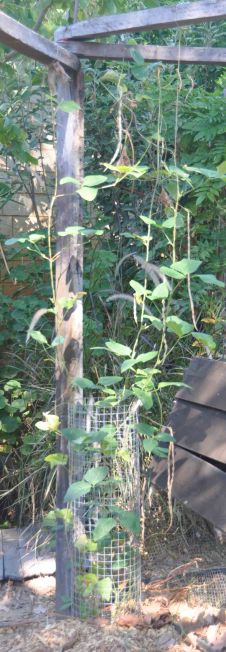



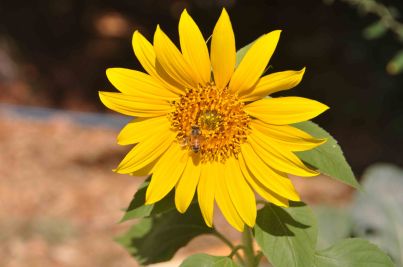
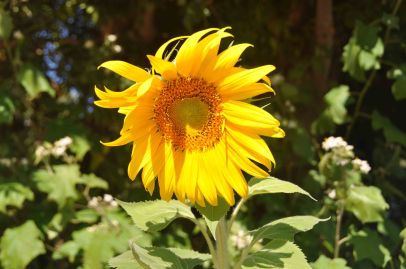



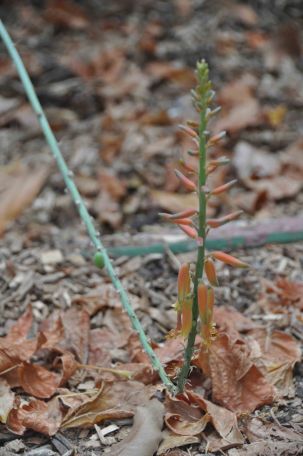




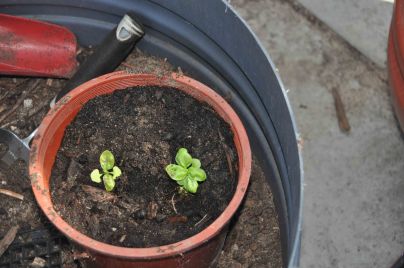


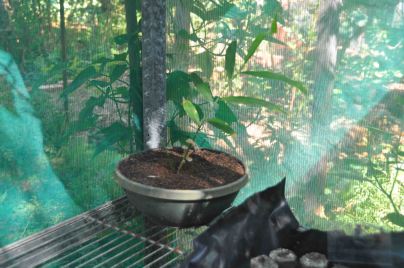





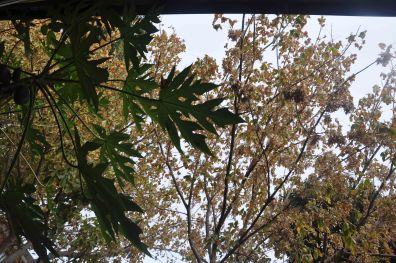



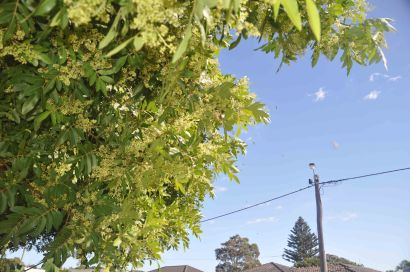




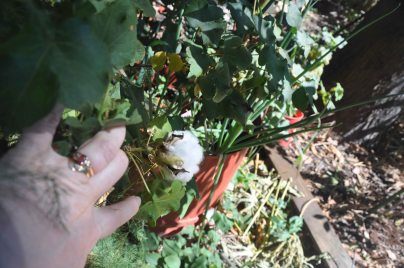

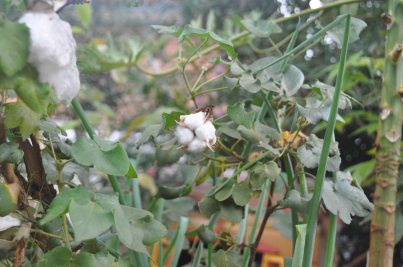


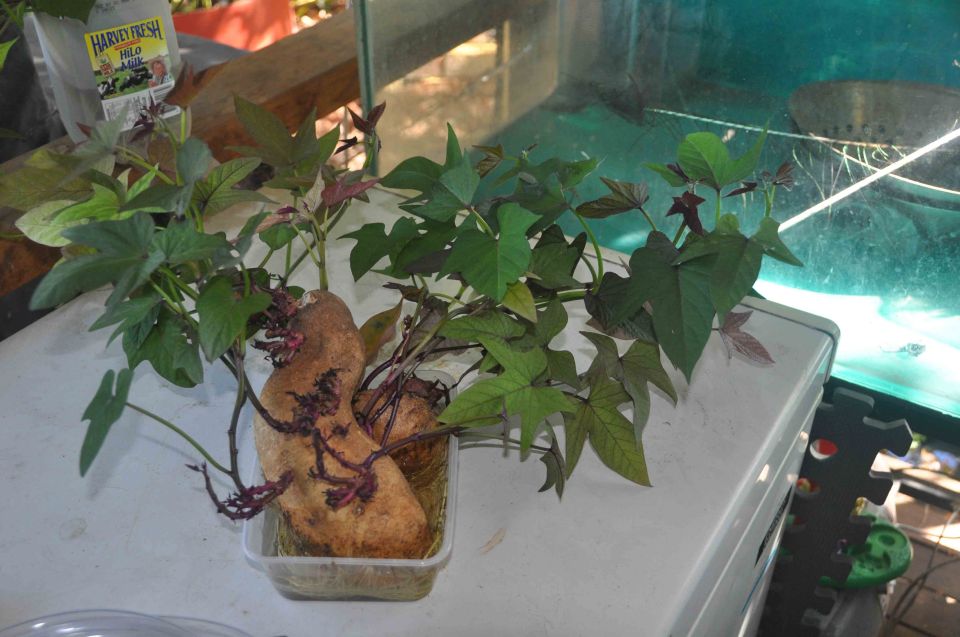
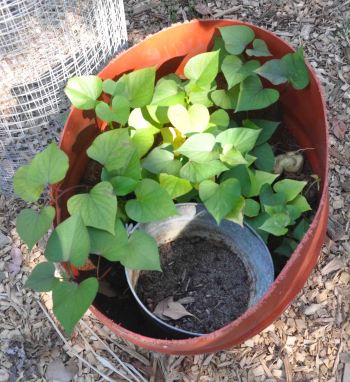
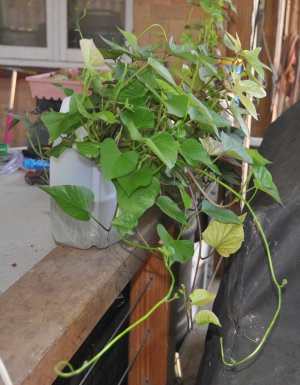

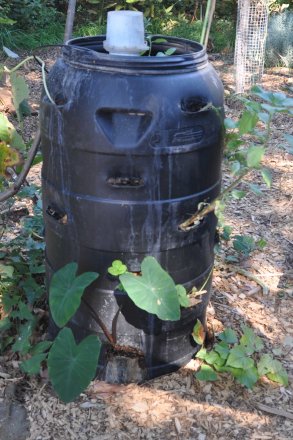


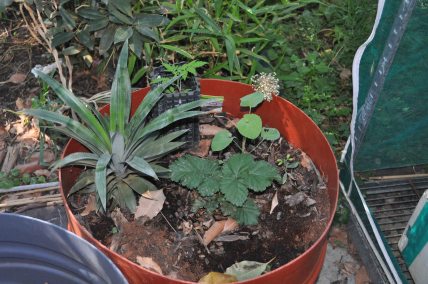

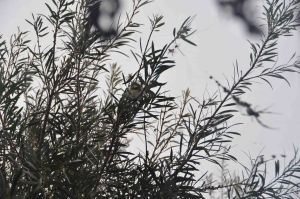
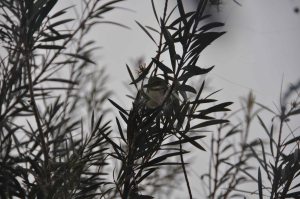
What about the tunnel collapse??…Will try to think of the good mole crickets are doing for the soil next time they’re driving me crazy! 🙂
LikeLike
Hi Carole, I figured I’d managed to kill two of the four seedlings, they only killed one….. note to self – with my track record and allowing for more sacrificial anodes, I need to start off with more seedlings in the first place!
LikeLike
Pingback: Festivals, Fetes and Fun | The Soil Hugger's Journey